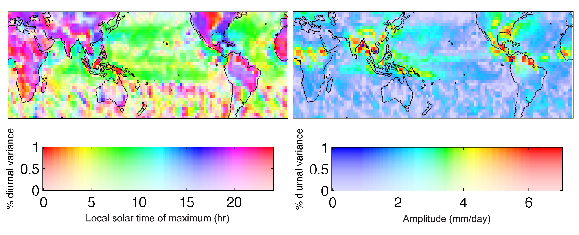I often use the word “diurnal” when talking about daily cycles. This is somewhat of a hot topic in atmospheric science, because model’s generally do a very bad job of producing rain at the right time (Lee et al. 2007, Pritchard and Somerville, 2009). This isn’t a problem for the general problem of understanding anthropogenic climate change, but it becomes more of an issue when we want to zoom in and understand region specific effects of climate change. Below is an interesting figure from Pritchard and Somerville (2009) that uses an HSV color coordinate to describe the phasing (left) and amplitude (right) of the peak daily precipitation during northern hemisphere summer from TRMM data. There’s a lot of interesting patterns to look at here, but the great plains of the united states has a particularly interesting signal.

The daily cycle of rainfall from the TRMM satellite. Phase, or peak timing, is on the left, and the amplitude of peak rainfall is on the right.
Using “diurnal” to describe an 24-hour cycle is not completely wrong. Most definitions of “diurnal” indicate that it can be used this way (see examples here, here and here). However, I want to argue that there is a better word, and that word is “diel“. This term is mostly used in biological research circles, but I don’t see why we can’t use it in atmospheric science.
The distinction is that “diurnal” and “nocturnal” describe when something with a daily cycle preferentially happens during the day or night hours, respectively. Diel describes something that has a 24-hour cycle, but is ambiguous as to when the “peak” of the cycle occurs.
Disclaimer: I realize this is a stupid semantic issue that no one really cares about, but I thought it was interesting.

I just read the short essay of Walter Hannah [August 12, 2014] about using diurnal, nocturnal, and diel cycles in atmospheric science. It was a good explanation. [From me, that is a high complement.] Besides the definition, I was struck/amused by his disclaimer that he thinks this “is a stupid semantic issue that no one really cares about.” As a professional technical editor, mostly of papers dealing with marine biology, I have a different perspective. Manuscript editors do care about such differences–it IS a matter of semantics. My work is almost entirely with researchers who are native Spanish speakers and they routinely use incorrect terms to describe a process or concept. I do not want journal editors and reviewers to find semantic and syntactic errors in my clients’ writings. It makes their work less frustrating and makes the researchers at my institution look like “bright candles”.
Ira, thanks for the comment. I’m glad people do care about semantic issues. I agree they are important, but I try not to get worked up about them because it’s so difficult to make people use their language correctly.
Another semantic issue not to get too worked up about: A /day/ is 24 hours long. It is also used to mean /daylight/, which refers only to that part of the day when the sun is up.